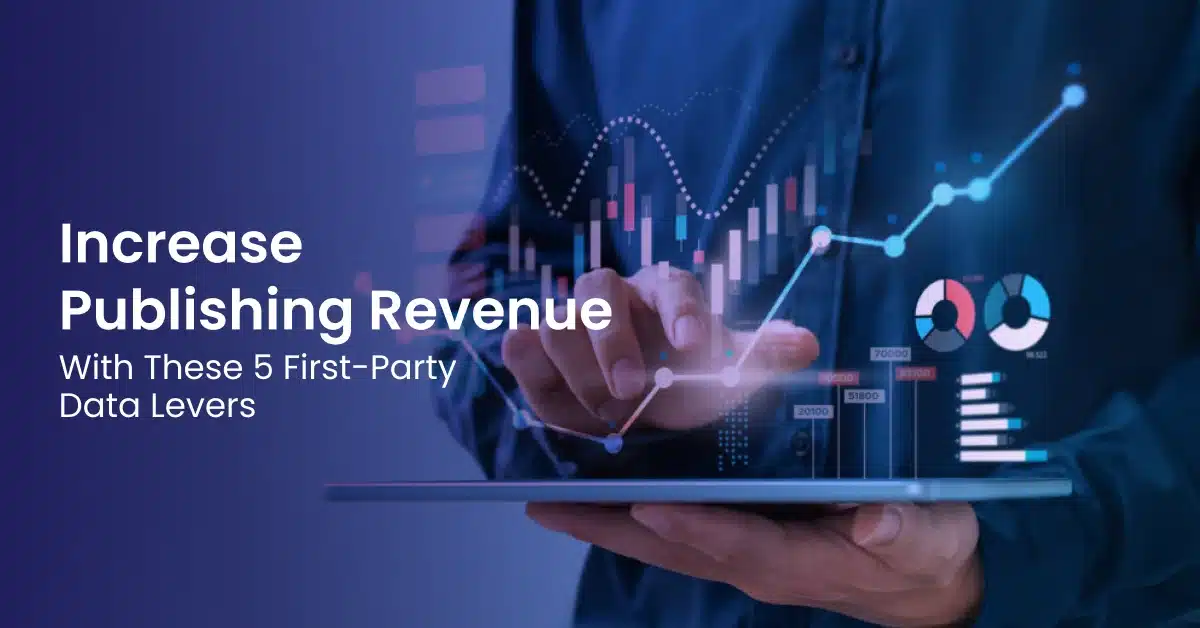First-party data is the future for publishers because the most popular browsers – Google Chrome and Apple Safari – no longer support third-party cookies.
Wait, What Is First-Party Data?
Before you can boost revenue with first-party data, getting your team on the same page is important. First-party data is information that a publisher directly obtains from a reader, subscriber, or member of an audience. The following first-party data examples show what this includes:
- Online Event Participation: If a publisher offers live digital events, you can gather first-party data from those events. For example, you can gather information about clicks and chat comments during a live event.
- Customer Data: When a person buys a subscription to a publication, a publisher gains more data about them, including their location, news preferences, and media preferences. In most cases, data from paying subscribers is the most valuable variety of first-party data.
- Email Marketing Analytics: Publishers that send out emails to their subscribers quietly gather data with every open and click. Since this data is connected to specific email users, email analytics data is a fantastic resource.
- Website Analytics: Good news – you’re probably already using this form of first-party data. Many publishers are already collecting data points like clicks, page views, and time on site through their website analytics platform.
Want the full story on cookieless future? See our post: The Future of Cookies In Marketing Strategy.
What The End of Third-Party Cookies Means For Your Advertisers
To improve your alignment with advertisers, put yourself in their shoes. Advertisers have built successful business models based on third-party cookies for nearly two decades. Then, a series of data privacy scandals, new laws, and changes to popular web browsers brought about the end of third-party cookies.
The old way of delivering highly relevant personalized advertising based on third-party cookies no longer works. Yet, the need to deliver effective online advertising isn’t going away.
For publishers, the shift to first-party data is a once-in-a-generation opportunity. Brands need a reliable way to reach their audiences while ensuring brand safety. Unlike social media platforms, which continue to struggle with toxic content of various kinds, publishers have an advantage thanks to their focus on high editorial standards.
First-party data is the future, and advertisers need data to reach their growth goals. Let’s find out how publishers can drive top-line revenue growth with first-party data.

Increase Publishing Revenue With These 5 First-Party Data Levers
First-party data drives revenue growth most effectively when you continuously gather data from your audience. That level of first-party data gathering is a team sport! Earn buy-in from management and colleagues by connecting the dots between improved first-party data and revenue growth.
Revenue Growth Lever 1: Increase Value for Advertisers
Winning advertiser dollars for your publication is easier when you have robust first-party data. You can offer advertisers a wider variety of segmentation options based on how the audience engages with your content.
For example, an advertiser might want to appeal to new parents. With first-party data, you can filter your audience for people interacting with content related to families, fertility, and related topics. That segment is far more likely to convert for the advertiser than a generic segment based on age and gender.
Revenue Growth Lever 2: Drive Digital Audience Growth
A publisher with a steadily growing, engaged online audience can thrive even when the online world shifts.
First-party data directly supports audience growth because you can make data-driven editorial decisions. For example, you’ll better understand which content and experiences your audience wants. Further, you can test and optimize word of mouth and sharing campaigns to grow your audience. In other words, your editorial strategy will hit more home runs over time by leveraging first-party data.
A growing digital audience means more website users and pageviews, which translates into more ad revenue!
Revenue Growth Lever 3: Get More Paying Subscribers
Many customers are willing to pay for access to premium digital content. Just look at the number of paying subscribers that streaming services have. Netflix had over 200 million paying subscribers as of 2023. It’s not just digital streamers that are succeeding. The New York Times has over 9 million paying digital subscribers as of 2023. There’s no doubt: customers are willing to pay for access to quality content
First-party data is your secret weapon in growing your number of paid digital subscribers. How? Analyze the first-party data generated by your paying subscribers. For example, analyze new customers’ behaviors in their first 30 days. A large percentage of your paying subscribers make a habit of reading their favorite columnists each week. In that case, emphasizing premium access to your columnists can be a winning angle to emphasize in your ads.
First-party data also helps you launch more targeted appeals to different audience segments based on their engagement with your publication. For example, you can create sports-oriented subscription ads for one audience segment and political news ads for a different segment.
Revenue Growth Lever 4: Boost Ecommerce Revenue
Selling subscriptions isn’t the only way for publishers to generate revenue. Media companies have offered merchandise (e.g., apparel, notebooks, books by your staff) for years. Digital products, like audio/video recordings and NFTs (non-fungible tokens), represent another opportunity to sell.
First-party data lifts ecommerce sales in several ways:
You can make better decisions about which products to create and promote by looking at audience behavior. For example, your super fans and heavy users are the most passionate about your publication. Promoting branded products like prints, posters, and apparel to your passionate audience segment is more likely to succeed than a general appeal.
Second, first-party data supports more effective segmentation and personalization when developing product ideas. Before committing to manufacturing products, you can gather first-party data about audience preferences. This can be as simple as emailing your subscribers to ask them to join a waitlist for a new product. If you see a significant amount of sign-ups for the waitlist, that first-party data suggests it is worth going ahead to create a product.
Revenue Growth Level 5: Increase Customer Loyalty
Subscriber churn is a problem for many problems. McKinsey research found that “nearly 40 percent of e-commerce subscribers have canceled their subscriptions.” This customer churn tendency will also apply to a publisher’s subscription!
When quitting a subscription feels like clicking a button on a website, it’s no wonder that people leave their subscriptions. There is another way!
When you offer community events and connections to your subscribers, canceling means saying goodbye to friends!
Community – the network of relationships formed around your content and events – is an essential intangible asset. When your audience sees your publication as a community hub, they’re less likely to switch to alternatives. Over time, such increased loyalty translates to higher renewal rates and fewer cancellations.
First Party Growth: A Quick Start Guide For Publishers
In three moves, you can organize first-party data and use it to fuel growth.
1. Get To Know Your First-Party Data
Most publishers already have some form of first-party data in their systems. The challenge is that this data is spread across multiple teams and apps. To assemble this data, look at website analytics, mobile device analytics (e.g., mobile web and mobile apps if applicable), and email marketing analytics. Ensure you check in with your peers in sales, marketing, analytics, and subscriptions to identify your first-party data.
Once you have identified your first-party data resources, you can build a “single source of truth” for subscribers. This means organizing your data to track a subscriber’s activities across multiple devices, channels, and experiences.
2. Assign Budget & Resources To First Party Campaigns & Testing
To gain the benefits of first-party data, committing to acting on it is essential. This could be as simple as setting a goal of creating at least two tests per month based on first-party data. Whether you start small or invest deeply in data,
3. Use Engagement Technology To Grow Website Engagement
Most publishers are already gathering website analytics and email data. While valuable, those sources of first-party data are more common. Therefore, building an advantage based on that data is more complicated.
Adding Arena Live Chat and Live Blog to your website gives your audience new ways to engage. Instead of looking at pageviews, you can look at chat interactions and logs. You’ll grow audience loyalty and get more data by offering more online community experiences that resonate with your audience.
How To Get More First-Party Data With Arena
The end of third-party cookies will change the world of online advertising and publishing. That change creates a new opportunity for publishers to grow their audiences and attract advertisers.
The essential ingredient is growing your online audience and continuously gathering first-party data. Learn more about Arena’s solutions for publishers.



